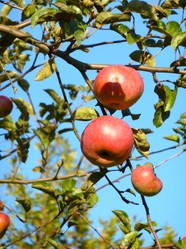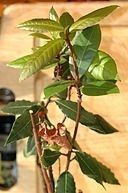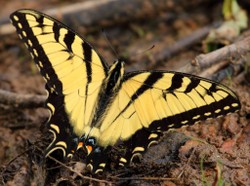Growing fruit is an enjoyable and rewarding past time for many people, and this is hardly surprising when you consider the amount of fruit which can be obtained from just one tree. In addition, the blossoms produced by fruit trees encourage an array of beautiful and beneficial insects into your garden.
Nevertheless, a recurring question asked by many would be gardeners is not 'How do you plant fruit trees?' but 'When do you plant fruit trees and where should you plant them?'






 A Colorful Journey: Comparing and Contrasting Mexican Folk Art With Polish Folk Arton 09/05/2024
A Colorful Journey: Comparing and Contrasting Mexican Folk Art With Polish Folk Arton 09/05/2024
 Exploring Traditional Japanese Tapestry Landscape Art: A Window into Nature’s Serenityon 09/01/2024
Exploring Traditional Japanese Tapestry Landscape Art: A Window into Nature’s Serenityon 09/01/2024
 Are Border Collies Really the Smartest Dog Breed?on 08/20/2024
Are Border Collies Really the Smartest Dog Breed?on 08/20/2024
 A Writer's Guide To Wizzley- A Gem of A Bookon 04/10/2013
A Writer's Guide To Wizzley- A Gem of A Bookon 04/10/2013


Comments
A bad snowstorm ended March even as a bad rain storm and a bad wind day Thursday figured this week.
But the spring-peeper frogs (Pseudacris crucifer) have been spring-peeping off and on this week and last. They indicate imminent spring times and weather.
A Unitedstatesian saying looks at late Easter -- this year not until April 20! -- and late spring.
But might that not manifest this year? This Sunday or next Sunday net 70-degree-Fahrenheit weather even as the days in-between nestle into mid- to late 60s.
Wouldn't that sound like indoor-planting what will be my fruit-tree collection within the next years?
The historical record can be so amazing and fascinating.
It still is possible to invoke Mount Vernon plantings at the very time of President George Washington (Feb. 22, 1732-Dec. 14, 1799)!
For example, the first Unitedstatesian president liked as fruit trees lime and mulberry. He liked as nut trees Spanish chestnut!
When might he have planted the above-mentioned trees?
President Washington referred to the Gardener's Calendar and relied upon his own science-reinforced experiences!
The Unitedstatesian saying affirms a late-arriving Easter with a late-departing winter.
Easter 2025, at April 20, dates just five days short of its latest delay to April 25.
Hardy, plucky wild strawberries favor end-March to first-week November flourishings.
So might there be fruiting plants for candied, chocolate strawberries April 20?
Very likely, with planted-tree fruits perhaps in a year to 2 or 3 years hence ;-D!
Fruit trees can be planted monoculturally or multiculturally.
In a way, I like orchards planted in the astute way that President George Washington (Feb. 22, 1732-Dec. 14, 1799) planted his grove at Mount Vernon.
Is there any British, Cornish, Irish, Scots or Welsh president known for sensitive plantings?
(This side of the Atlantic pond matches planting know-how with King Charles III!)
Tovah Martin, in The indestructible houseplant, advises us about appropriate light, nutrients, soil pH, temperature and watering.
The aforementioned authoress considers two other influences that, like the above, configure happy health to houseplants.
Atmospheric moisture and night-time temperatures matter!
They must matter to fruit trees too, mustn't they?
The computer crashed before I communicated another component of my observation and question in the comment box immediately below.
Indoor plants interest me what with weather too cold for outdoor gardening. Woody plants always intrigue me what with bush, shrub, tree, vine importance to atmospheric, land, sentient-being and water health.
Dwarf fruit trees might be the indoor answer, correct?
The first paragraph to the third subheading, Planting citrus trees, advises us that "Citrus trees should be planted after the possibility of any ground frost has passed, spring is usually ideal. Choose a sunny position with well drained soil. Many citrus tree varieties thrive in climates which have long warm summers, however, they are only likely to survive if they are planted in regions that experience mild winters."
Have you ever included citrus trees among your houseplants?
Ismail Kadare (Jan. 28, 1936-1 Jul 1, 2024) included a lemon tree in her apartment for his heroine in his novel The concert.
A citrus tree inside is such an appealing, photogenic, practical, scented, tasty, versatile ornamental!
Hi Sheri,
You are so lucky, I'd love to grow more exotic types of fruit in my garden. But living in the UK, we're really limited as to types we can grow because of our often appalling and very unpredictable weather. And thank you very much for linking to Squidoo article, that's very kind of you. :)
2uesday, I have made the same mistake myself. A few years ago I had to have the fencing removed on one side of my garden (it was 6 ft high) and have it replaced with 4ft fencing panels because I could not get to back of the bush( it wasn't a fruit tree) to trim and prune and it and it wasforcing the fencing to lean into my neighbours garden, it was unsafe. So, much of this article is born from bitter experience! :)
I love having fruit trees in my yard. Since moving to Israel I can get great exotic types. This is a good reference you have put together here and I'm linking it to my squidoo article on fruit trees.